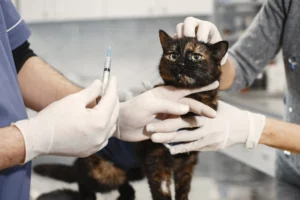If you’re wondering why your cat’s pad is swollen, you’re not alone. It’s a common concern among cat owners and can be a cause for worry. In this blog post, we’ll explore the reasons behind this issue and provide you with some helpful insights on what you can do to help your feline friend.
Swollen Cat Paw Pad: What Could Be the Cause?
Injury or Trauma
If you’re wondering why your cat’s paw pad is swollen, one possible reason could be injury or trauma. Cats are curious creatures, and they can easily injure themselves by stepping on something sharp or getting into a scuffle with another animal. These incidents can cause inflammation and swelling in the paw pad, making it painful for your feline friend to walk on.
In such cases, it’s essential to examine the paw pad carefully for any signs of cuts, bruises, or foreign objects embedded in the skin. If you notice any wounds or suspect trauma, it’s best to seek veterinary attention immediately. Your vet can assess the extent of the injury, provide necessary treatment, and ensure your cat is comfortable during the healing process.
Infection
Another common reason behind a swollen paw pad in cats is infection. This can occur when bacteria enter a wound or when a foreign object becomes lodged in the paw pad, leading to inflammation and swelling. If left untreated, infections can worsen and cause severe discomfort for your furry companion.
If you notice your cat’s paw pad is swollen and accompanied by redness, heat, or discharge, it’s crucial to consult your veterinarian promptly. They can prescribe antibiotics or other appropriate treatments to clear up the infection and alleviate your cat’s discomfort. Remember, early intervention is key to preventing the infection from spreading and causing further issues.
Additionally, keeping your cat’s living area clean and free of sharp objects can help prevent future infections and injuries. Regularly inspecting your cat’s paws for any abnormalities and addressing them promptly can go a long way in ensuring your feline friend stays happy and healthy.
Remember, your cat’s well-being is in your hands, so stay vigilant and proactive when it comes to their health and safety.
Allergies
If you’re wondering why your cat’s pad is swollen, allergies could be the culprit. Environmental factors like pollen, grass, or household cleaning products, as well as food allergies, can cause paw pad swelling in cats. To help alleviate this issue, try switching to hypoallergenic cat litter or changing your cat’s diet to eliminate potential food triggers. Additionally, consider using pet-safe cleaning products and limiting your cat’s exposure to allergens. If the swelling persists, consult your veterinarian for further guidance and potential treatment options.
Autoimmune Disorders
When it comes to paw pad swelling in cats, autoimmune disorders, such as pemphigus, could be to blame. These conditions occur when the immune system mistakenly attacks the body’s own cells, leading to inflammation and swelling in the paw pads. It’s crucial to seek prompt veterinary care for a proper diagnosis and treatment plan. Your vet may recommend medications to suppress the immune response or topical treatments to soothe your cat’s swollen pads. Keep a close eye on your furry friend’s symptoms and follow your vet’s guidance for managing autoimmune-related paw pad swelling.
Additional Unique Insight:
– Regularly inspect your cat’s paw pads for any signs of swelling, redness, or irritation. Catching issues early can help prevent discomfort and further complications. If you notice any abnormalities, consult your veterinarian promptly for proper evaluation and treatment.
Remember, your cat’s comfort and health are top priorities, so stay vigilant and proactive in addressing any paw pad swelling concerns.
Insect Bites or Stings
If you notice your cat’s paw pad is swollen, it could be due to insect bites or stings. Pesky critters like bees or wasps might have taken a nibble, causing irritation. To help alleviate discomfort, try applying a cold compress to reduce swelling. Keep a close eye on your feline friend for any signs of allergic reactions, such as difficulty breathing or excessive swelling beyond the paw pad area. If these symptoms arise, seek immediate veterinary care. Remember, prevention is key; consider using pet-friendly insect repellents in outdoor spaces to keep your cat safe from bites and stings.
Overgrown Claws
An often overlooked reason for paw pad swelling in cats is overgrown claws. If your cat’s claws are too long, they can curl back and irritate the paw pads, leading to discomfort and swelling. Regular nail trims are essential for maintaining your cat’s paw health. If you’re unsure how to trim your cat’s nails safely, consult your veterinarian or a professional groomer for guidance. Additionally, provide scratching posts or pads to help your cat naturally wear down their claws. Remember, a little trimming now can save your cat from big paw problems later.
Helpful Tip:
– To make nail trimming less stressful for your cat, start slow and use treats to reward good behavior. Patience and positive reinforcement go a long way in keeping your cat’s claws in check.
For further information on paw issues in cats, you can check out this resource from the American Association of Feline Practitioners: Cat Health Topics
Cancer
If you notice your cat’s paw pad is swollen, it could be due to a variety of reasons, including the rare possibility of cancer. While cancer causing paw pad swelling in cats is uncommon, it’s crucial to take any abnormal swelling seriously. If you suspect cancer as a potential cause, it’s essential to seek prompt veterinary evaluation. Your veterinarian can perform tests to determine the underlying cause of the swelling and recommend the appropriate course of action. Remember, early detection and treatment are key in managing serious conditions like cancer in cats. Don’t delay seeking professional help if you’re concerned about your feline friend’s health.
Home Remedies vs. Veterinary Care
When it comes to treating minor paw pad swelling in cats, there are some at-home remedies you can try, such as soaking the paw in warm water or applying a mild antiseptic solution. However, it’s important to differentiate between minor swelling that may resolve on its own and more serious cases that require veterinary care. If the swelling persists, worsens, or is accompanied by other concerning symptoms, such as limping or excessive licking, it’s crucial to seek professional veterinary care. Your vet can accurately diagnose the underlying issue and provide appropriate treatment to ensure your cat’s well-being. Remember, your cat’s health should always be a top priority, so don’t hesitate to reach out to your veterinarian for guidance.
Additional Unique Insight: Be cautious with home remedies and avoid using any products that haven’t been specifically recommended by your veterinarian. Some over-the-counter treatments may be harmful to cats and could exacerbate the problem rather than help. When in doubt, always consult with your vet before trying any home remedies for your cat’s paw pad swelling.
Remember, your cat’s paw pad swelling could be a sign of a more serious underlying issue, so it’s always best to err on the side of caution and seek professional veterinary care when in doubt. Your furry friend’s health and well-being are worth the extra effort and attention.
Fun Fact: Cat Paw Pads
Did you know that cat paw pads are not just cute, but they serve a crucial purpose for our feline friends? These specialized cushions help cats maintain their balance, provide traction for running and jumping, and even regulate body temperature. So, the next time you see your cat’s paw pads, remember just how important they are for their daily activities.
In conclusion, a swollen cat paw pad can signal various underlying issues that require attention and care. By staying informed and proactive, you can ensure your furry companion receives the necessary support for optimal paw health.
Common Causes of Swollen Cat Paw Pads
Allergies: Just like humans, cats can have allergic reactions that result in swollen paw pads. Common allergens include certain foods, plants, or environmental factors.
Infections: Bacterial or fungal infections can cause inflammation and swelling in your cat’s paw pads. It’s essential to seek veterinary attention for proper diagnosis and treatment.
Injuries: Your cat may have injured their paw, leading to swelling and discomfort. Check for signs of cuts, bruises, or foreign objects stuck in their pads.
Remember, if you notice your cat’s paw pad is swollen, it’s crucial to consult with your vet for a proper diagnosis and treatment plan.
Adding a high-authority external link related to cat paw health for further reading: American Association of Feline Practitioners – Caring for Your Cat’s Paws
Alex, a passionate animal lover, has experience in training and understanding animal behavior. As a proud pet parent to two dogs and three cats, he founded AnimalReport.net to share insights from animal experts and expand his knowledge of the animal kingdom.









